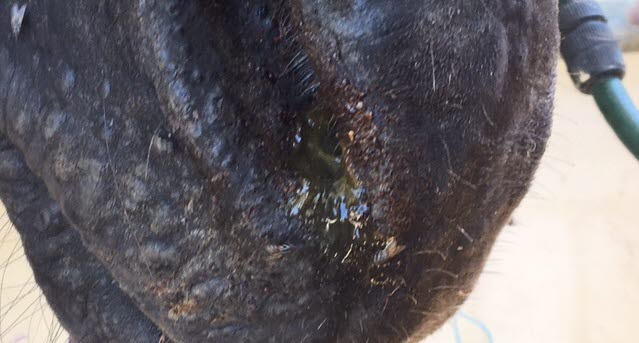Strangles

Strangles is a serious and highly contagious respiratory disease of horses. It is caused by the bacterium Streptococcus equi subspecies equi and is found worldwide.
Clinical signs
Horses typically develop clinical signs within 3 to 8 days of coming into contact with the bacteria. Not all horses succumb to the disease once exposed. The age, immune status, and number of bacteria all affect whether or not a horse will suffer from the respiratory disease. For example young horses with a lower immunity are more likely to suffer from the disease than more mature horses. Signs that your horse is suffering from strangles may include:
- A nasal discharge, often mucopurulent (green/white and thick) (pictured above)
- Pyrexia (an increased temperature); anything above 38.6◦C
- Depression; moving around less, the horse may be dull and listless
- Coughing
- Reduced appetite/anorexia
- Swellings under the head and chin as a result of enlarged pus-filled lymph nodes
- The lymph nodes may even eventually burst open, draining pus
- The enlarged lymph nodes may occlude the windpipe causing restricted or noisy breathing, thus the name ‘strangles’
- Other body systems may become involved, such as the chest, abdomen or brain. This is known as ‘bastard strangles’ and can present in a variety of ways
- Formation of immune complexes can damage the blood vessels and may result in swelling of the head, neck, limbs and even cause death. This is known as ‘Purpura Haemorrhagica’
- Some horses may be infected and show minimal or no clinical signs
In classic uncomplicated strangles horses usually recover uneventfully within a few weeks, but it can be fatal for some horses. Recovered horses commonly shed bacteria in respiratory secretions for up to six weeks and a small percentage may become carriers for years without any outward signs.
Transmission
Strangles can be spread directly from horse to horse, or indirectly via objects shared between horses, such as grooming tools, clothes and troughs. Risk of transmitting strangles is increased at places with high numbers of horses from different areas such as competitions. Ways of preventing spread of the disease include:
- Isolating any new horses for three weeks, monitoring for any clinical signs of strangles and taking their temperatures twice daily
- Allow a vet to examine all new horses before mixing with other horses on the property
- Any horses suspected of having strangles should be isolated from other horses immediately
- Disinfectant, different equipment and different clothes should be used when dealing with this horse and a vet sought immediately
- Vaccination using the strangles vaccine should be discussed with your vet. This does not necessarily completely prevent strangles, but will make the episode much shorter and less severe
- Suspected carriers can be identified by your veterinarian who will collect some samples from your horse for laboratory testing
Treatment
Antibiotic therapy for strangles is controversial but likely to be most useful very early in the disease process. This should be decided by your veterinarian and is considered on a case-by-case basis. If severe swelling of the abcessed lymph nodes has occurred it may be necessary to lance them to aid breathing. Nursing care such as warm compresses to encourage bursting of the abscess may be advisable.
The prognosis for most horses following strangles is very good, but some post infection complications can occur, such as inflammation of the heart muscle, anaemia, guttural pouch infection, or permanent airway problems. Horses should be isolated for 8 weeks after cessation of clinical signs, and ideally at the end of this time have samples taken to ensure they are not carriers of the disease.
This content was originally published by Equine Veterinarians Australia (EVA), a special interest group of The Australian Veterinary Association.
Photos courtesy of Dr Clare Williams-Paterson.
